When you think of German food, bratwurst and beer probably pop into your head first, right? But honestly, after wandering through Germany’s food scene, I realized there’s so much more bubbling beneath the surface than just sausages and steins.
Germany serves up seven distinct culinary adventures that highlight regional specialties, age-old baking, and cozy comfort foods that have shaped European kitchens for ages.
As I explored Germany’s kitchens and bustling markets, I noticed every region beams with pride over its signature dishes. You’ll find crispy schnitzels in Bavarian beer gardens, and pretzels twisted by bakers who’ve clearly mastered their craft.
German food has this cool way of mixing rustic comfort with refined technique. It’s not all heavy or bland—there’s a surprising balance of hearty and subtle flavors here.
Beyond the usual wurst, I stumbled on dishes that warm you up in the winter and celebrate whatever’s fresh from the fields. These seven food experiences totally flipped my idea of what German cuisine is all about.
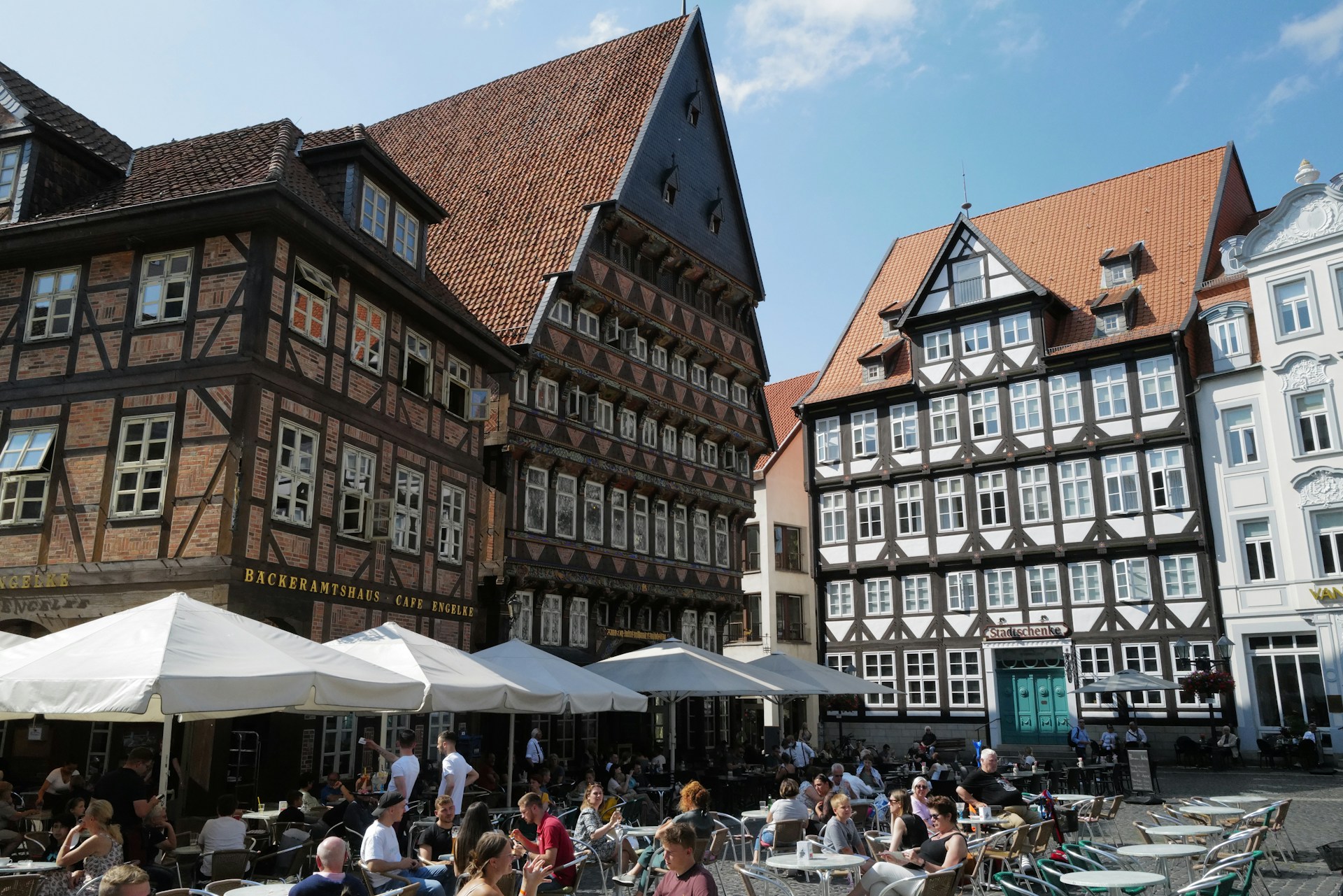
Foundations of German Culinary Heritage
German cuisine gets its soul from regional traditions, time-honored cooking styles, and big moments in history like the World Wars and the Berlin Wall. Geography plays a huge role—coastal towns lean into fish, while the heartland loves its meats.
Centuries of swapping ideas with neighbors brought new flavors and techniques into the mix.
Regional Diversity in German Cuisine
The flavors in Germany change wildly as you travel north, south, east, or west. Each spot has its own food identity, shaped by what grows or swims nearby.
In the north, seafood and briny flavors rule. Coastal cities serve up Labskaus—a quirky sailor’s stew—and fresh Fischbrötchen sandwiches. The chilly weather calls for food that sticks to your ribs.
Head south and it’s a whole new ballgame. Bavaria and Baden-Württemberg are famous for soft pretzels, Sauerbraten (that tangy pot roast), and Black Forest Gateau. Savory mains and decadent desserts both get their moment.
| Region | Key Ingredients | Famous Dishes |
|---|---|---|
| North | Fish, potatoes, cabbage | Labskaus, Fischbrötchen |
| South | Beef, wheat, cherries | Sauerbraten, Black Forest Cake |
| East | Potatoes, pickled vegetables | Soljanka, Kartoffelpuffer |
East Germany has its own vibe, with dishes like Soljanka soup and Kartoffelpuffer (potato pancakes) nodding to Soviet influences. Meanwhile, the west started modernizing old recipes with international twists.
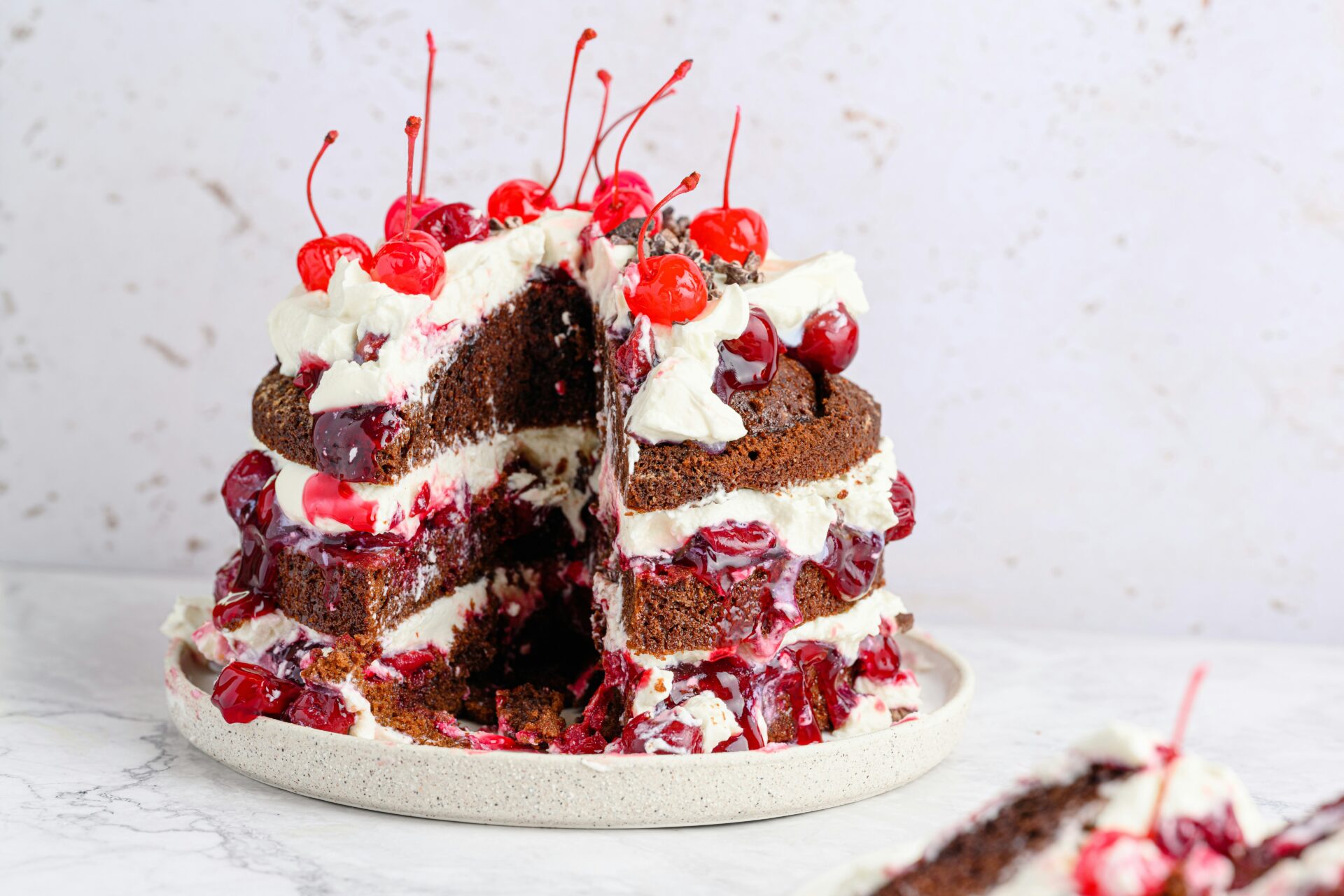
Traditional Cooking Techniques
German cooks really lean into a few time-tested techniques. These methods give the food that signature heartiness and warmth.
Braising turns tough cuts into fork-tender magic. Think Sauerbraten, where the meat soaks in marinade for days before it gets that low-and-slow treatment.
Smoking is big in the north, especially for fish. It adds deep, rich flavor and keeps food fresh longer.
Fermentation brings us sauerkraut and all kinds of pickled veggies. Cooks use special crocks called Sauerkrauttopf to let cabbage get that tangy kick. It’s a clever way to keep veggies going through the winter.
There’s more:
- Grilling makes bratwurst and sausages sing.
- Baking is practically an art form when it comes to bread.
- Poaching keeps fish delicate and moist.
These aren’t fast-cook shortcuts. They take time and care, but the flavor payoff is so worth it.

Influence of History on Food Culture
Big events have shaped what Germans eat. Wars, politics, reunification—all of it left a mark.
During the World Wars, food shortages pushed cooks to get creative with whatever was on hand. Hearty, filling meals became the norm, stretching ingredients as far as possible.
The Berlin Wall didn’t just split the country; it split food culture, too. East Germany leaned into Soviet-inspired recipes, and dishes like Soljanka soup became everyday fare.
After reunification in 1990, old East German recipes made a comeback. People wanted to reconnect with their roots, and suddenly, forgotten dishes popped up on menus again.
Trade routes brought in new spices and ideas. Germany’s spot in the middle of Europe made it a crossroads—French finesse, Polish comfort, Austrian baking—they all left their fingerprints.
Today, every dish here feels like a little piece of history, shaped by centuries of swapping, adapting, and reinventing.

German Beer Culture and Iconic Beer Experiences
Beer in Germany isn’t just a drink—it’s a way of life. From laid-back beer gardens where families gather, to wild festivals that celebrate brewing traditions, German beer culture feels woven into every day.
The Role of Beer in German Society
German beer culture surprised me with its casualness. Folks have a beer with lunch, no big deal. That after-work Feierabendbier? It’s practically a ritual.
Beer brings people together, not just for parties but for everyday meals and backyard barbecues.
A few things I noticed:
- You can legally drink beer and wine at 16
- Beer’s everywhere—supermarkets, train stations, even vending machines
- Public drinking? Usually fine
- People care more about quality than quantity
With over 1,500 breweries and more than 5,000 beer brands, there’s no shortage of options. Many breweries are still family-run, passing down secrets for generations.
The Reinheitsgebot (Beer Purity Law) from 1516 still matters. Originally, brewers could only use water, barley, and hops.

Beer Gardens and Social Traditions
If you want to experience German beer culture, hit up a beer garden (Biergarten). These aren’t just about drinking—they’re about community.
Traditional beer gardens have their own quirks. You can bring your own food, but drinks are bought on-site. Long tables mean you’ll probably end up chatting with strangers.
Why beer gardens work:
- Chestnut trees give cool shade
- Wooden benches invite everyone to squeeze in
- Families are welcome
- Food’s simple—pretzels, sausages, potato salad
Some beer gardens stay open year-round, heaters and hot drinks included. Munich alone has over 100, and Augustiner-Bräu can seat a jaw-dropping 8,000 people. It’s old-school tradition, but it feels fresh every time.
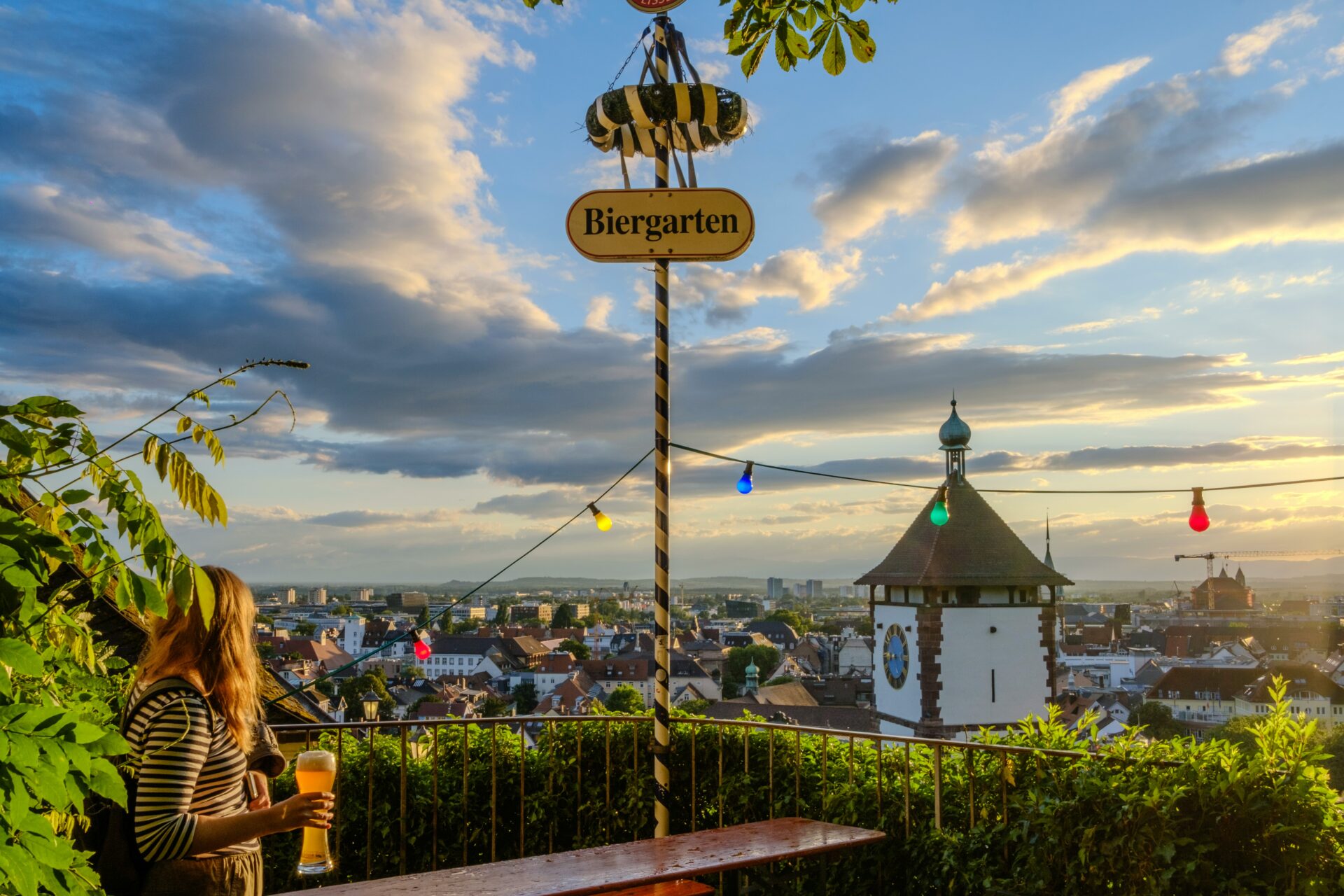
Exploring Oktoberfest and Regional Festivals
Oktoberfest gets all the press, but Germany throws beer festivals all over the place. Munich’s bash draws over 6 million visitors, who down about 7 million liters in just 16 days.
A few other fests worth checking out:
- Starkbierfest (Munich): Strong beer, strong vibes, every March
- Cannstatter Volksfest (Stuttgart): Second only to Oktoberfest
- Bamberg Rauchbier Festival: All about smoky brews
Each region celebrates its own beer style. Cologne pours Kölsch in skinny glasses, while Bavaria loves its cloudy, fruity Weizenbier. Nationally, Pilsner rules, but winter brings out the malty, boozy Bock and Doppelbock.
These aren’t just tourist traps—they’re genuine parties for locals and a window into real German life.
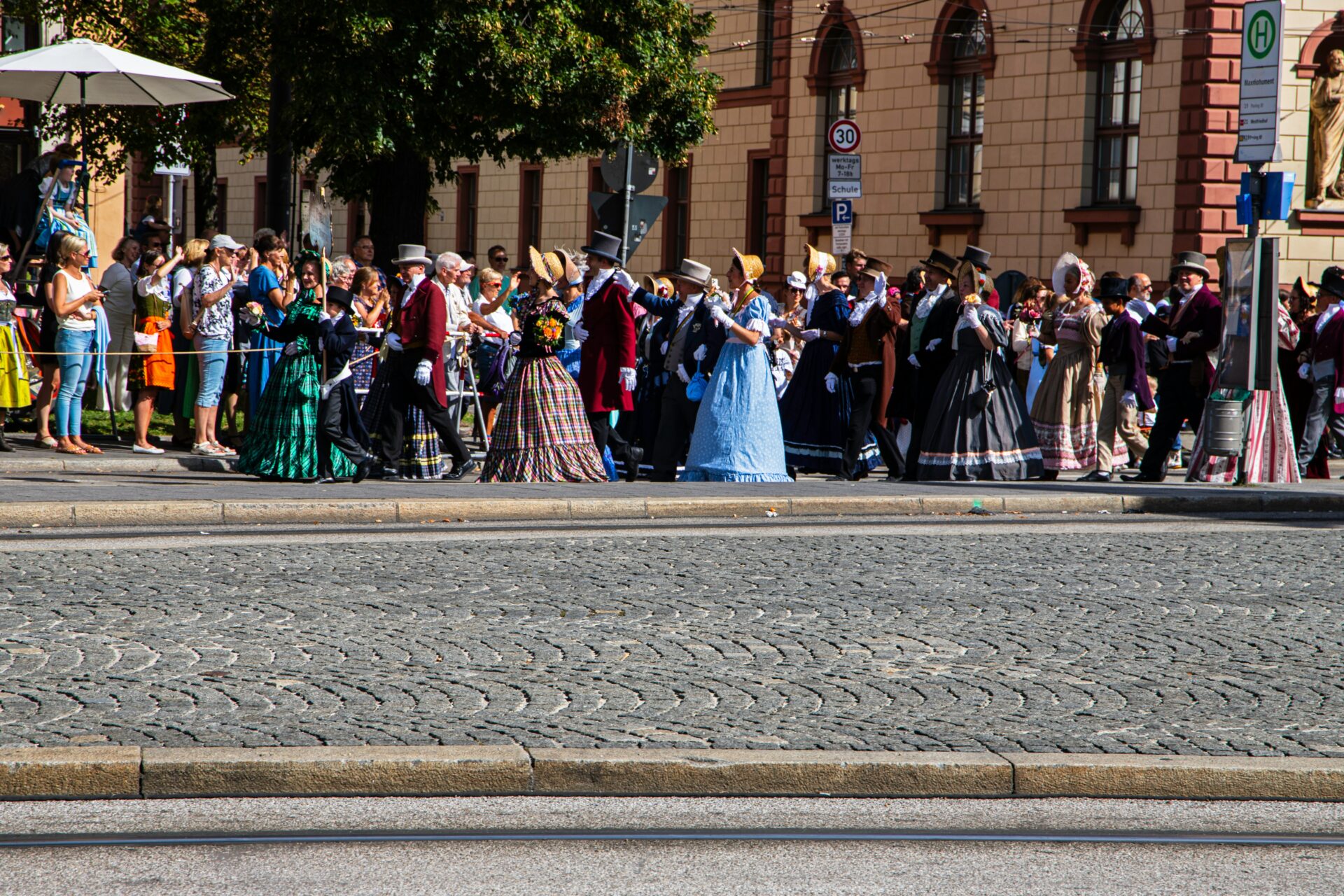
Schnitzel and Savory Specialties
Schnitzel might be Germany’s most iconic comfort food—tender meat, crisp breadcrumbs, and a squeeze of lemon. Every region puts its own spin on it, so you’ll never get bored.
Classic Pork and Veal Schnitzel
There are two schnitzel classics. Wiener Schnitzel uses veal, pounded thin, dipped in flour, egg, and breadcrumbs, then fried in plenty of lard.
Paniertes Schnitzel is the everyday favorite, made with pork. The process stays the same—thin, breaded, and fried until golden.
Both versions deliver that perfect crunch outside and juicy meat inside. Enough fat in the pan is the secret to a puffy, crisp coating.
Restaurants usually serve schnitzel with herbed potatoes or tangy coleslaw. That contrast between hot, crispy meat and cool sides just works.

Pairing Schnitzel with Lemon
Lemon and schnitzel? It’s a must. A squeeze of lemon brightens up the rich, fried flavor and keeps things from feeling too heavy.
I always wait until the last second to squeeze it on, so the crust stays crisp. It’s not just for taste—the citrus actually helps you digest a heavy meal.
You’ll see lemon wedges on every schnitzel plate in Germany. Without them, it just feels wrong.
Schnitzel Variations Across Germany
Different regions have their own schnitzel twists. Jägerschnitzel comes smothered in creamy mushroom sauce (sometimes with bacon).
Zigeunerschnitzel brings a tangy bell pepper and onion sauce. Up north, Schnitzel Holstein gets topped with fried eggs and even a bit of fish.
In Munich, I tried Bavarian Schnitzel—it’s brushed with sweet mustard and horseradish before breading for a spicy-sweet kick.
For a street food fix, grab a Schnitzelbrötchen—schnitzel on a crusty roll, with mayo, mustard, and pickles. Perfect for eating on the move.
Every version shows just how creative Germans get with a simple, satisfying idea.
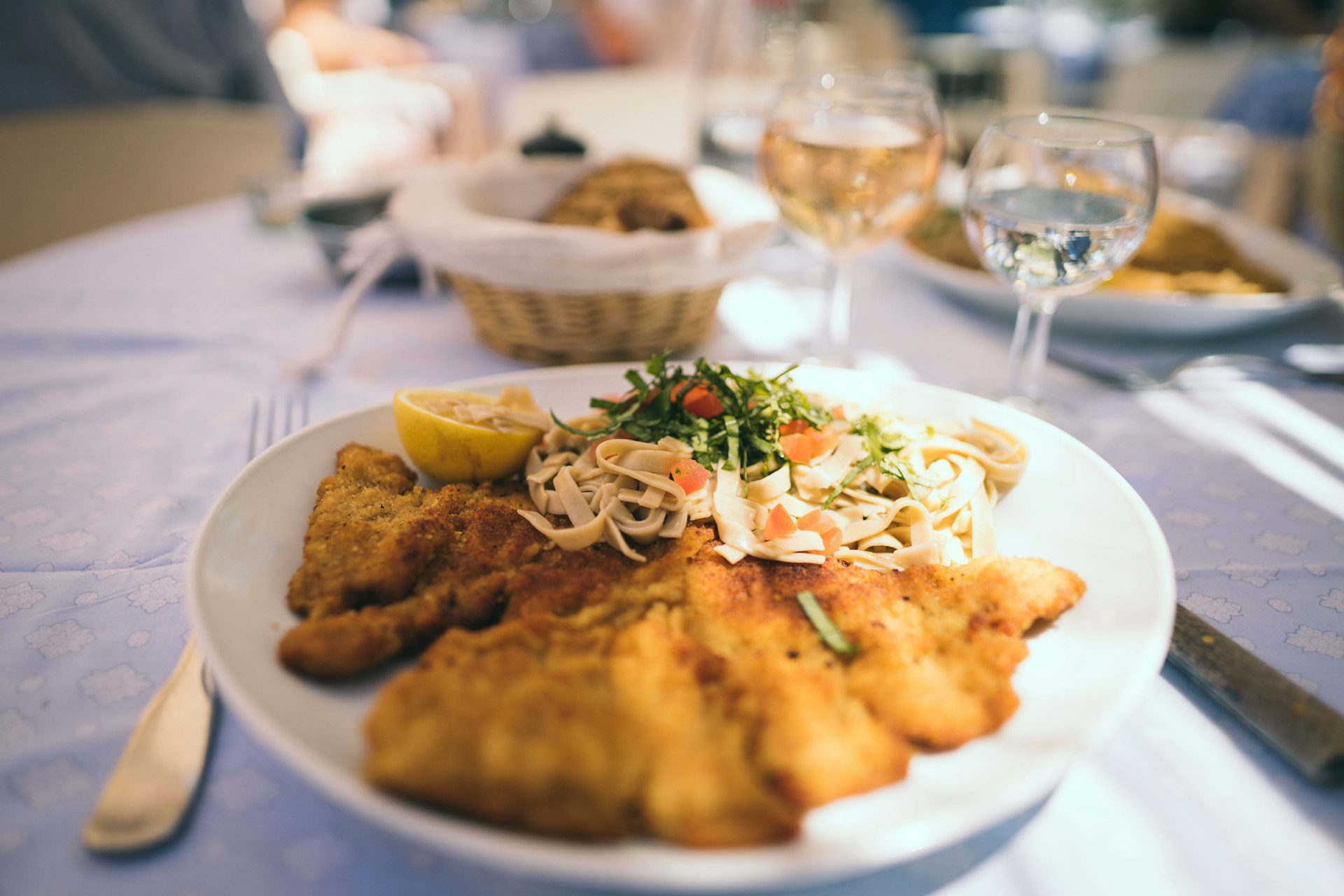
Beyond Wurst: Exploring German Sausages
Germany churns out over 1,500 sausage types, each with its own backstory. From Bavaria’s grilled bratwurst to Berlin’s legendary currywurst, these sausages are pure culinary tradition.
Bratwurst: Regional Styles and Preparations
Bratwurst isn’t just one thing—it changes from town to town. Each region swears by its own recipe.
Thüringer Rostbratwurst (from the east) packs in marjoram and garlic, and locals insist it has to be grilled over charcoal.
Nürnberger Rostbratwurst are tiny but mighty—served six at a time, usually with sauerkraut.
Weißwurst, the Bavarian breakfast staple, is a delicate veal sausage with fresh herbs. Folks eat it before noon, always with sweet mustard and a soft pretzel.
Most bratwurst gets grilled or pan-fried until the casing snaps. You’ll find them stuffed into rolls or served alongside mustard and bread.

Currywurst: The Berlin Classic
Currywurst is Berlin’s claim to fame. In 1949, Herta Heuwer mixed curry powder into tomato sauce and poured it over sausage—simple, brilliant.
Vendors slice up bratwurst or bockwurst, drown it in spicy-sweet sauce, and dust it with more curry powder. You’ll usually get fries or a roll on the side.
Berliners eat this everywhere, from street stands to late-night snack bars. The sauce goes from mild to fiery, depending on who’s serving.
Germans devour around 800 million currywurst a year. There’s even a museum celebrating it—because why not?
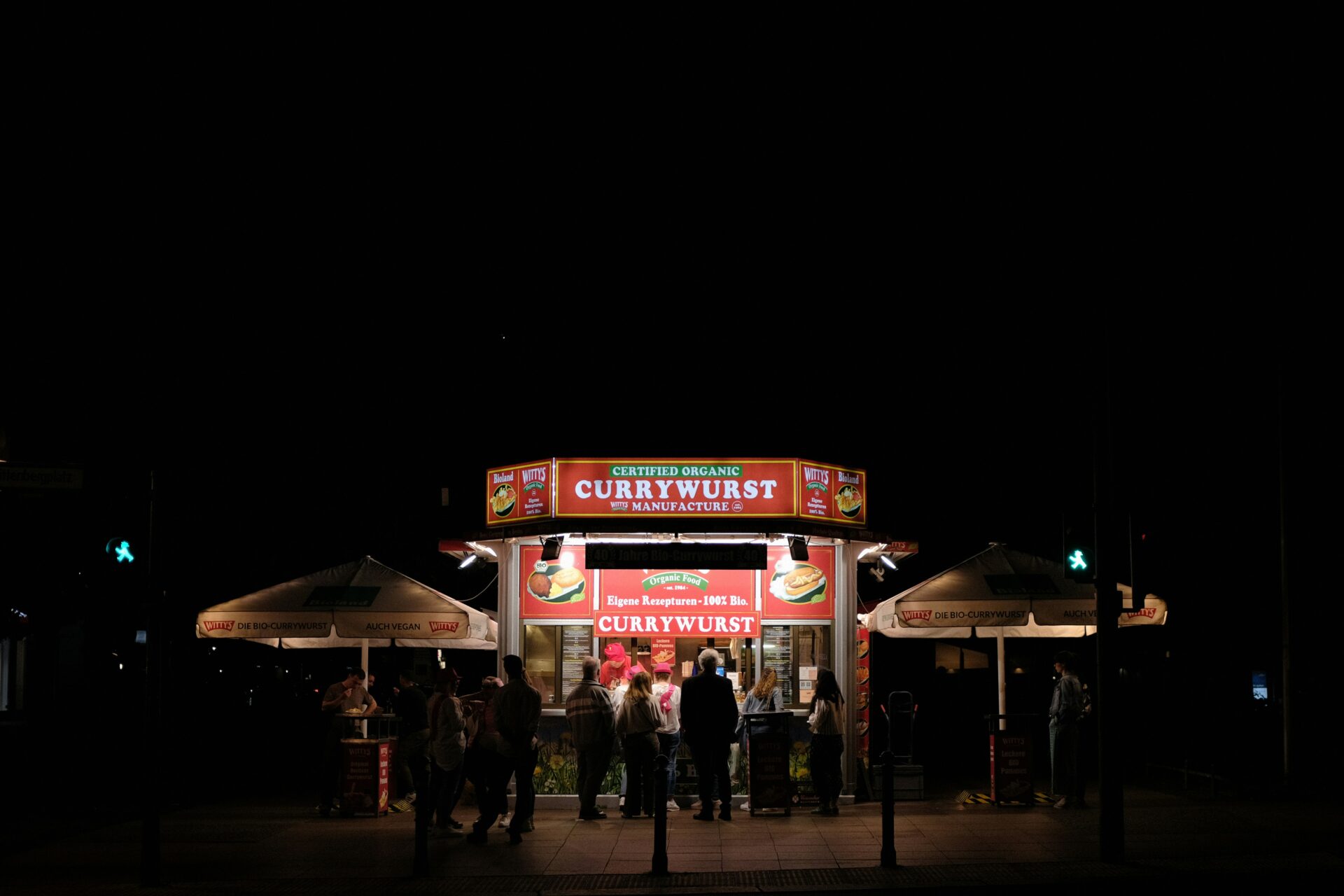
Other Unique Wurst Varieties
Leberwurst? This creamy liver sausage spreads so easily on bread, you barely need a knife. It’s made from pork liver, fat, and a blend of spices. Germans often reach for it at breakfast or for a light meal.
Bockwurst looks like a hefty hot dog, but it’s got a gentler flavor thanks to veal and pork. I usually boil it gently and serve it up with a dollop of mustard or spicy horseradish.
Knackwurst really lives up to its name—the snap when you bite in is half the fun. It’s a mix of beef and pork, with a solid hit of garlic. I love eating it with sauerkraut and mashed potatoes.
Mettwurst comes in both spreadable and sliceable versions. It’s raw, fermented, and smoked, so you get a flavor that’s a bit like salami but unmistakably German.
Every region in Germany has its own sausage specialties, shaped by local ingredients and family traditions. It’s honestly wild how much variety you’ll find just driving from one town to the next.
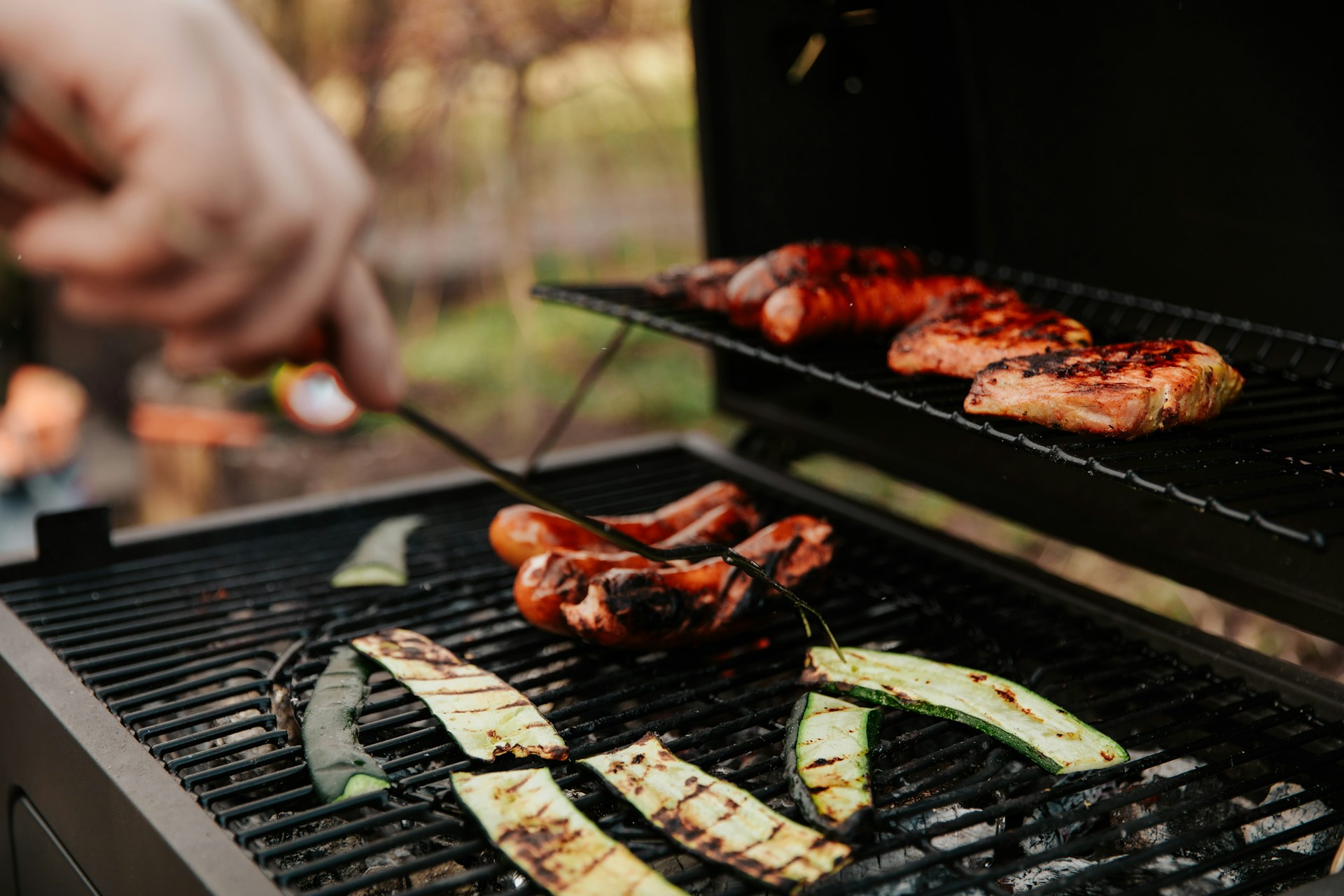
Beloved Comfort Dishes and Carby Delights
German comfort food? It’s all about hearty, filling plates that leave you warm and satisfied. Here are a few dishes that have kept German families happy for generations.
Spätzle: Germany’s Noodle Comfort Food
I stumbled onto spätzle down south, and honestly, I never looked back. These soft egg noodles are everywhere at the table. “Little sparrows”—that’s what the name means in Swabian, if you’re curious.
Why spätzle stands out:
- Just eggs, flour, and water or milk—nothing fancy
- Pressed by hand through a spätzle maker into boiling water
- Cooked till they float
The texture? That’s the magic. They’re tender, with a chewy bite that soaks up anything you pour over them.
I’ve had spätzle as a side with meat and gravy, but if you ask me, Käsespätzle—the German answer to mac and cheese—steals the show. Melted cheese, crispy fried onions, and those noodles? Yes, please.
Swabian families started making spätzle back in the 18th century, mostly with whatever they had in the pantry. If you want the best, head to Baden-Württemberg or Bavaria.
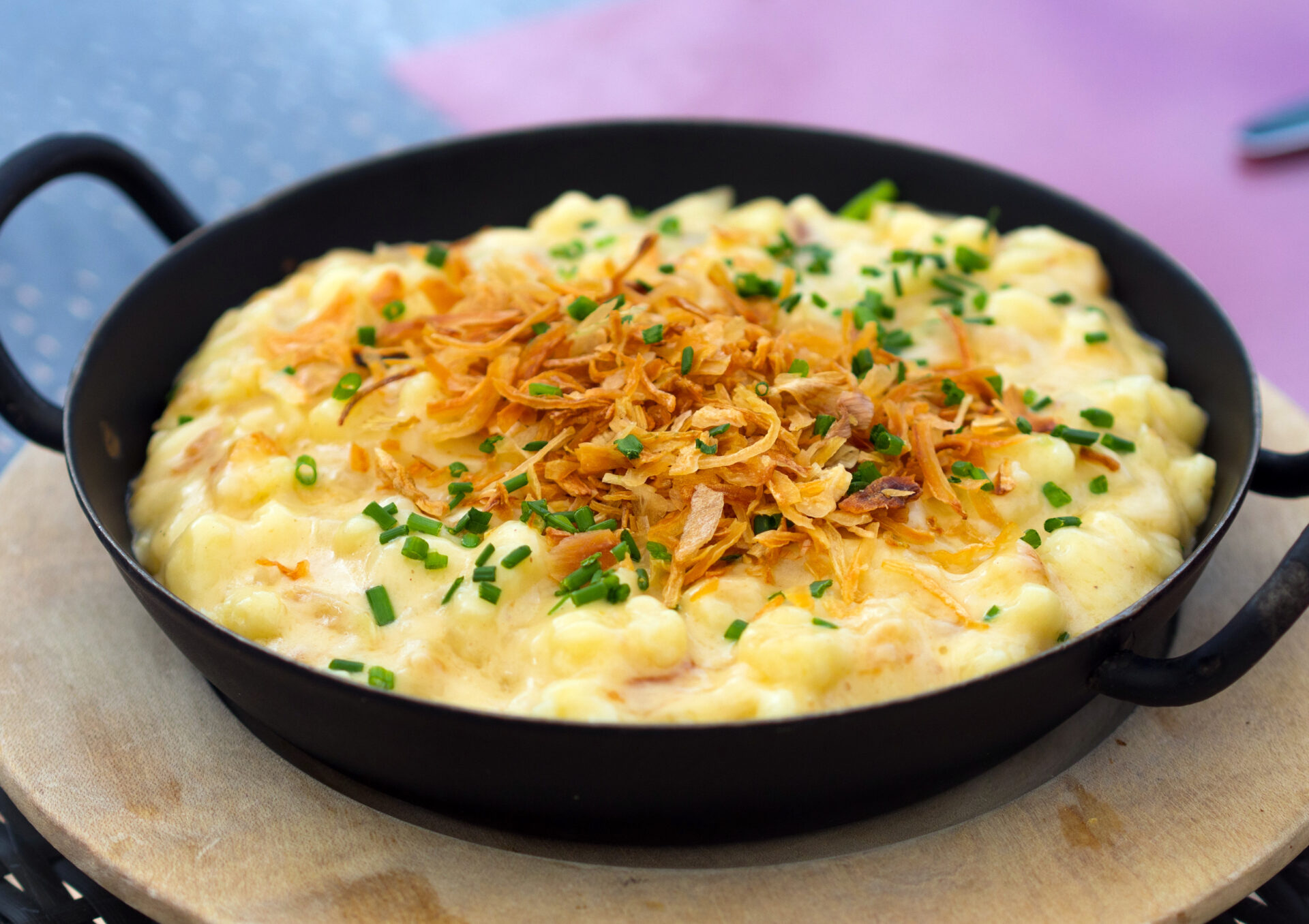
Flammkuchen: The German Flatbread
Flammkuchen means “flame cake,” and it hails from Alsace, right near France. My first bite was in a little German bakery, and I still think about it.
The base is super thin dough, rolled out flat. On top, you’ll find:
- Crème fraîche or sour cream
- Sliced onions
- Bacon bits (they call it speck)
Bakers used to make flammkuchen to test if their wood-fired ovens were hot enough for bread. Slide it in, and if it cooked right, the oven was ready.
You get crispy, smoky, tangy flavors all at once. The edges turn golden and crunchy, but the middle stays creamy. Sweet onions balance out the salty bacon, and it’s just perfect.
Some places add mushrooms, cheese, or even apples. Still, the classic version dominates menus across Germany.
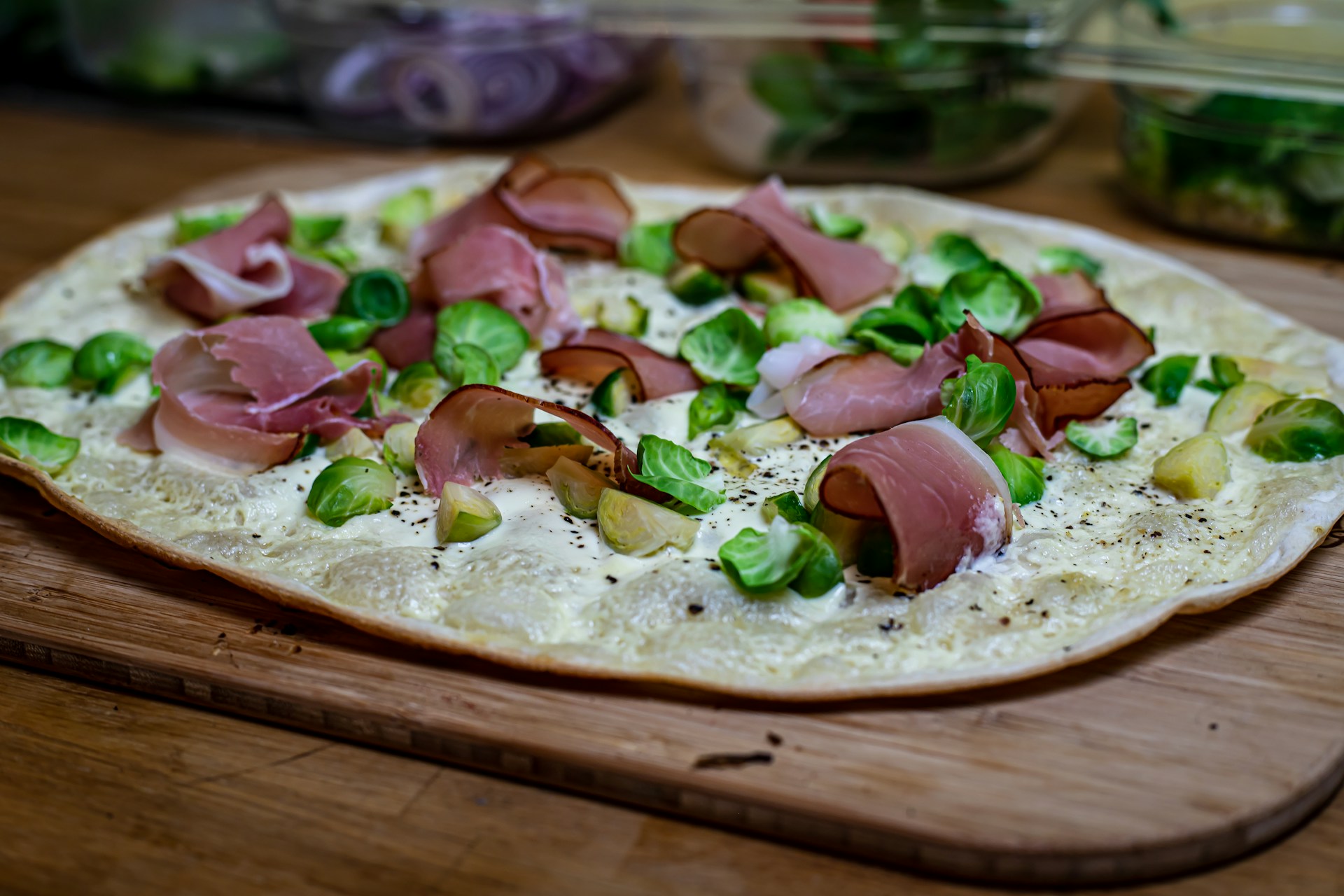
Pork Knuckle: Hearty and Flavorful
If you want a showstopper, order German pork knuckle—Schweinshaxe down south, Eisbein up north. This roasted pork leg easily feeds two, if not more.
Preparation changes by region. In Bavaria, they roast it till the skin crackles. Up north, folks boil it and serve it with sauerkraut and mashed peas.
On the side, you’ll usually get:
- Sauerkraut or red cabbage
- Potato dumplings or mashed potatoes
- Dark mustard
- Fresh bread rolls
Slow cooking makes the meat fall right off the bone, and that crispy skin? It’s the best part. I always dig in for the marrow—it’s a little treat if you ask me.
Beer halls all over Germany put pork knuckle front and center. It’s the kind of dish that begs for a cold beer and a long, lazy meal.
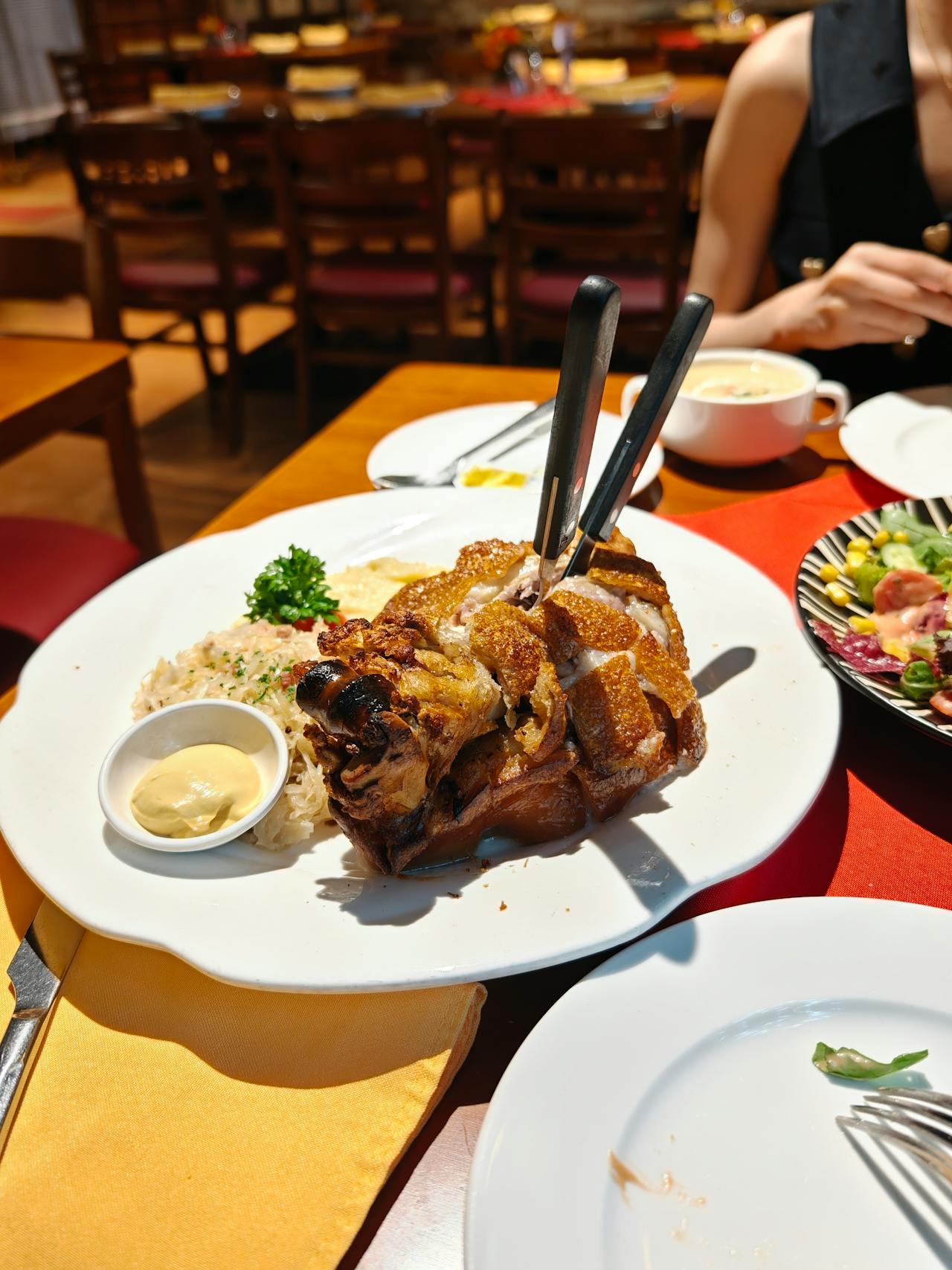
Bakery Treats, Pretzels, and Iconic Desserts
German bakeries are honestly next-level. You’ll find everything from twisted pretzels with big salt crystals to decadent Black Forest cake stacked with cherries and cream. These treats go hand-in-hand with local drinks and centuries of tradition.
Traditional Pretzels and Bread Culture
Forget those bagged pretzels from the States. The real German pretzel has a dark, chewy crust (thanks to a quick lye bath) and a soft, fluffy inside.
What makes them special? They’re topped with coarse salt, twisted by hand, then baked to perfection.
German bakeries crank out dozens of breads every day. Dense rye and seeded loaves are everywhere.
| Bread Type | Key Features |
|---|---|
| Pumpernickel | Dark, dense, a touch of sweetness |
| Vollkornbrot | Whole grain, hearty, super filling |
| Brezel | Classic twisted pretzel, salty crust |
Germans eat bread all day long. Breakfast usually means fresh rolls with butter and jam.
Pretzels aren’t just snacks—they’re sandwich bread, beer hall staples, and comfort food. Every region puts its own spin on them.
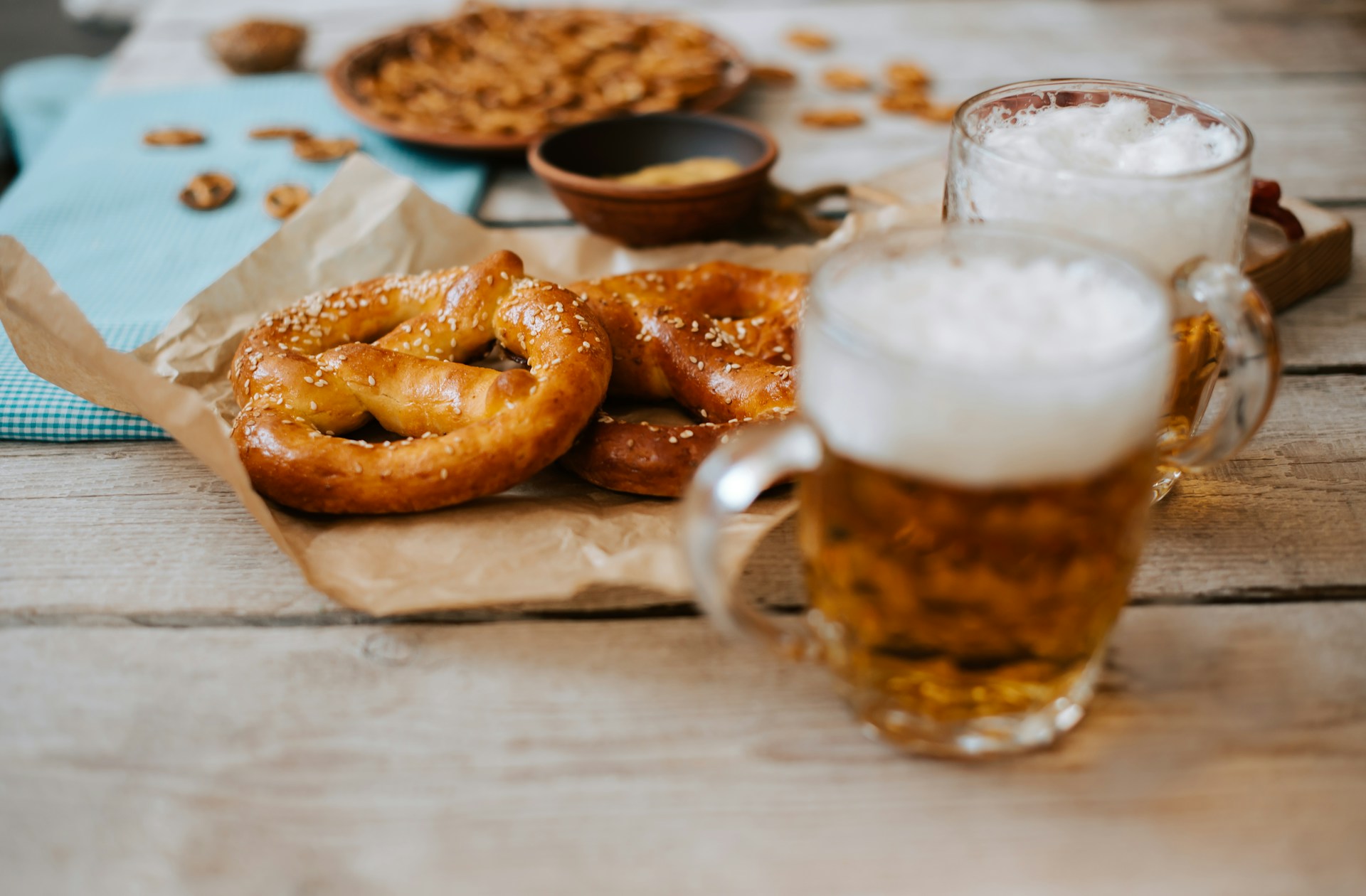
Sweets from the Black Forest
Black Forest cake is legendary for a reason. I tried it in the Black Forest itself, and wow—no going back.
The real deal: Chocolate sponge, whipped cream, sour cherries, and a splash of Kirsch cherry brandy.
The cake gets its name from the Black Forest region in southwest Germany. Local cherries and that Kirsch brandy are non-negotiable.
German apple cake is another classic. It’s a dense, buttery base topped with apple slices and cinnamon sugar.
Bakeries here shine with seasonal treats:
- Spring: Strawberry tarts with creamy custard
- Summer: Fresh fruit strudels
- Fall: Apple and plum cakes
- Winter: Lebkuchen spice cookies
Strudel pastries? They’re made with paper-thin dough, wrapped around fruit or cheese. It takes real skill to get it right.
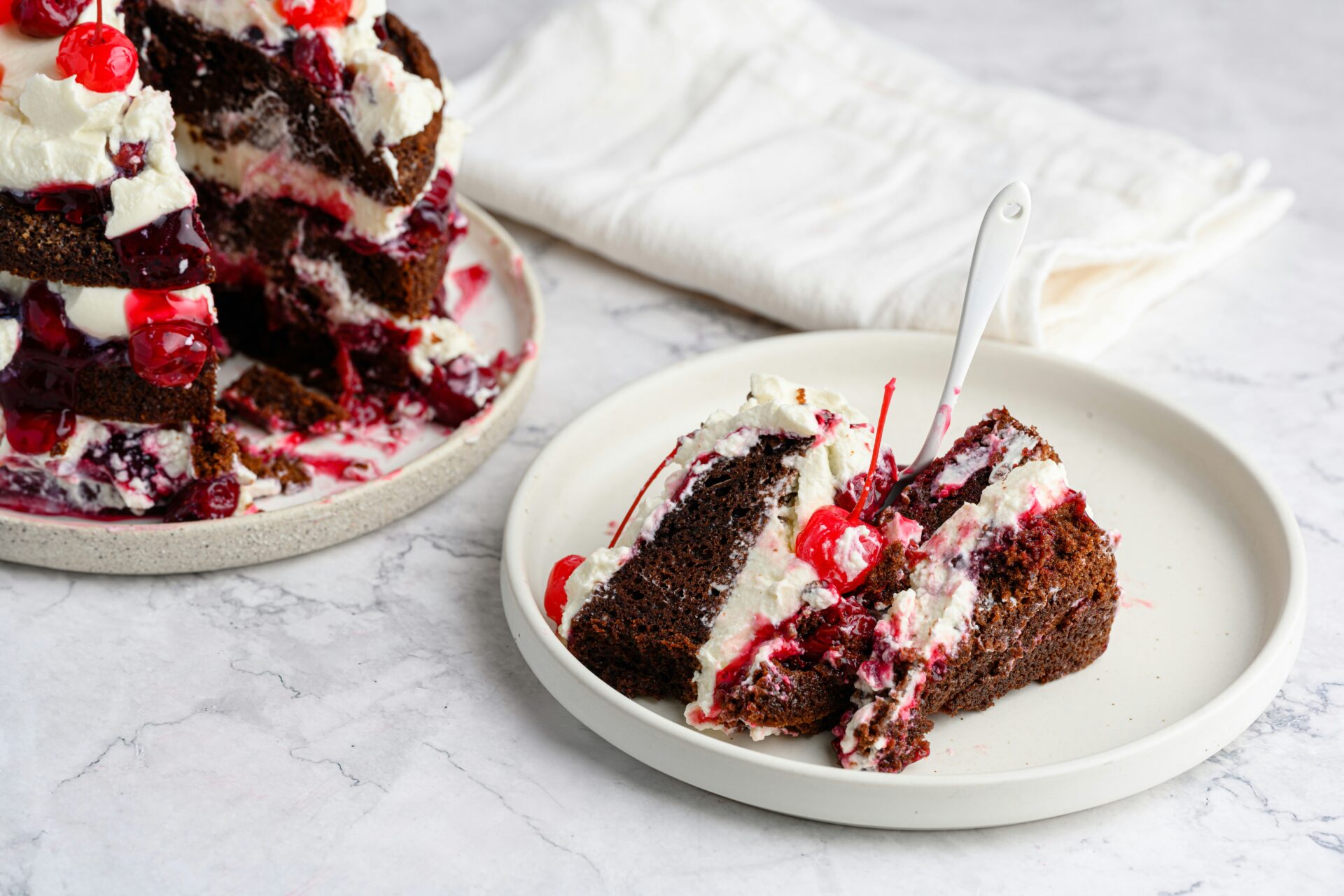
Pairing German Baked Goods with Drinks
German beer and pastries? Surprisingly, it works. Lighter beers go great with fruity desserts, while dark brews love chocolate.
Coffee rules the bakery scene. Afternoon coffee with cake—“Kaffee und Kuchen”—is basically a national pastime.
Classic combos include:
- Black Forest cake with strong coffee
- Apple strudel with black tea
- Pretzels with a fresh pint of beer
- Fruit tarts with crisp white wine
Bakeries brew rich, full-bodied coffee that pairs perfectly with sweets.
Up north, tea is a big deal, especially Earl Grey and black teas with fruit desserts.
Kids aren’t left out—bakeries offer milk drinks and hot chocolate, which is perfect with cookies or a light cake in winter.
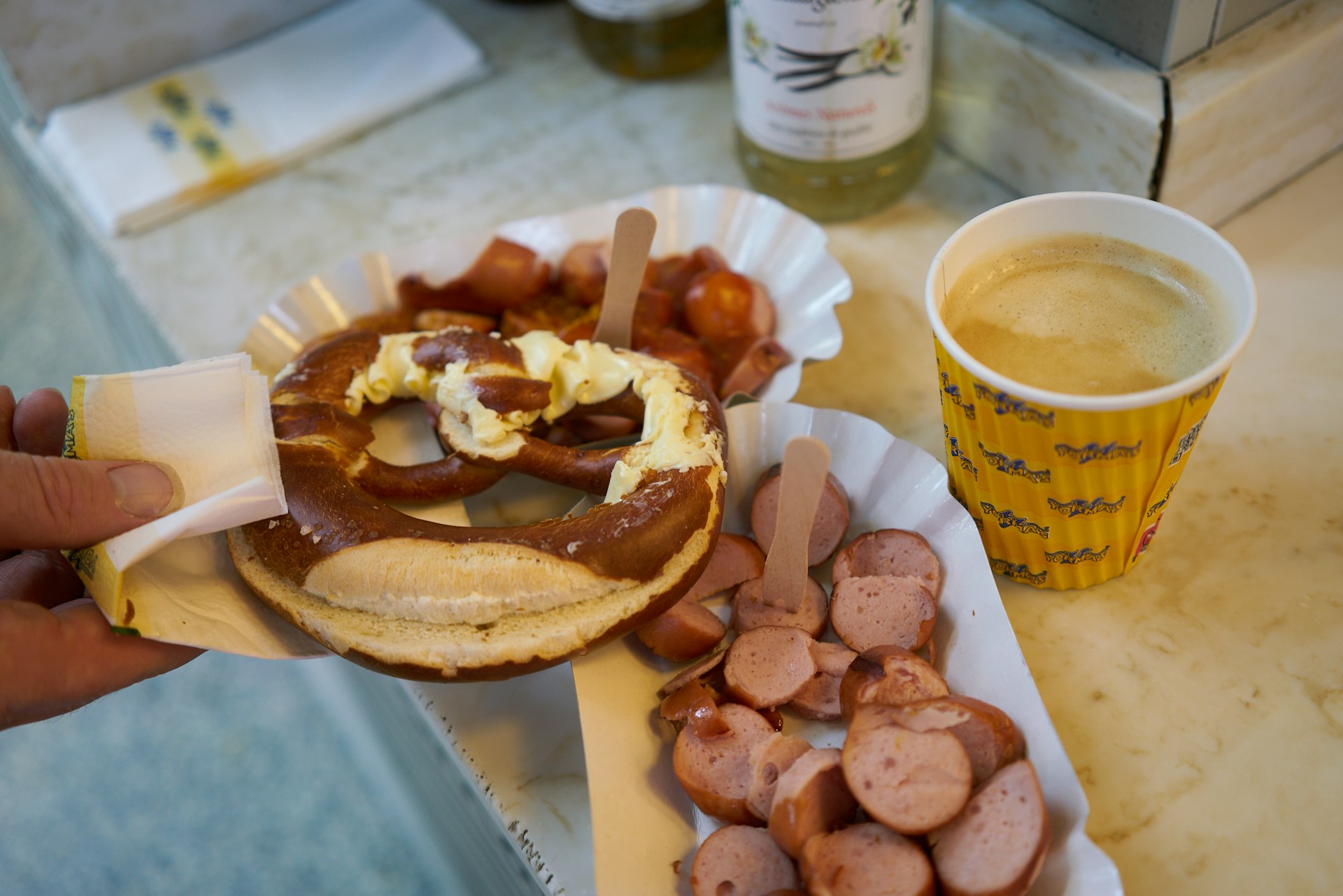
Frequently Asked Questions
I get a lot of questions from German food fans—what to eat, where to find the best dishes, and how to bring those flavors home. If you’re planning a trip or just want to cook like a local, these might help.
Start with Sauerbraten—marinated roast beef, slow-cooked until it’s fork-tender. It’s the soul of German comfort food.
Schnitzel is a classic too. That crispy coating and juicy meat make it a favorite everywhere.
Try Königsberger Klopse, which are meatballs in creamy caper sauce. The flavors are rich and tangy at the same time.
Currywurst is a must if you’re in Berlin. This spicy sausage dish is street food at its best.
I’ve found my favorite Sauerbraten in family-run “Gasthof” or “Gasthaus” restaurants. These places often cook recipes passed down for generations.
The Rhineland is the classic home of Sauerbraten. Cologne and Düsseldorf are great cities to start your search.
Bavaria offers its own twist, sometimes with different spices. Munich’s old beer halls usually have it on the menu.
Look for spots advertising “hausgemacht”—homemade. They’re more likely to marinate the beef the old-fashioned way.
I’ve used a few online German grocery stores that ship worldwide. The Taste of Germany has a big selection and ships just about anywhere.
German Deli is another good one for things like spaetzle, sauerkraut, and mustard. Their shipping is pretty reliable.
Some stores let you pre-order holiday treats, so you don’t miss out during German festivals.
Just remember, shipping can take a while—sometimes weeks. Order early if you need something special.
Northern Germany leans into seafood—think Labskaus and Rollmops. The coastal vibe makes the food feel totally different from the south.
Bavaria is all about hearty meat dishes, pretzels, and beer. Their food is rich and has a bit of Austrian flair.
The Rhineland mixes things up with dishes like Himmel un Ääd—mashed potatoes, apples, and black pudding. You’ll taste a blend of German and neighboring influences.
Eastern Germany’s food reflects its ties to Poland and Eastern Europe. Each region cooks with what’s local, so the flavors change as you travel.
Black Forest Cake is the big one—layers of chocolate, cherries, and whipped cream. It’s unforgettable.
Apple Strudel is another must. Flaky pastry, spiced apples, just the right amount of sweetness.
Lebkuchen are traditional gingerbread cookies—spiced, soft, and everywhere during Christmas (but you’ll find them year-round too).
German Cheesecake is lighter and less sweet than the American kind. I love it with fresh berries or a spoonful of fruit compote.
Let’s start with Maultaschen. Locals in Swabia whip up these hearty pasta pockets, stuffing them with meat, spinach, and herbs. People sometimes call them “German ravioli,” but honestly, that doesn’t do them justice—they’ve got a flavor all their own.
Next up: Himmel un Ääd. Imagine mashed potatoes and apples together on your plate. Sounds odd? It’s surprisingly good, especially when you add blood sausage into the mix. The sweet and savory combo catches a lot of people off guard, in the best way.
Flönz might raise a few eyebrows. This Cologne-area blood sausage doesn’t look like much, but the first bite reveals a rich, smooth flavor that’s hard to forget. I hesitated at first, but it won me over.
Don’t leave Germany without tasting Döppekuchen. Locals in the Rhineland bake up this layered potato and meat casserole, and it’s the kind of dish that sticks with you. It’s pure comfort food—most tourists never even hear about it, which honestly feels like a missed opportunity.

